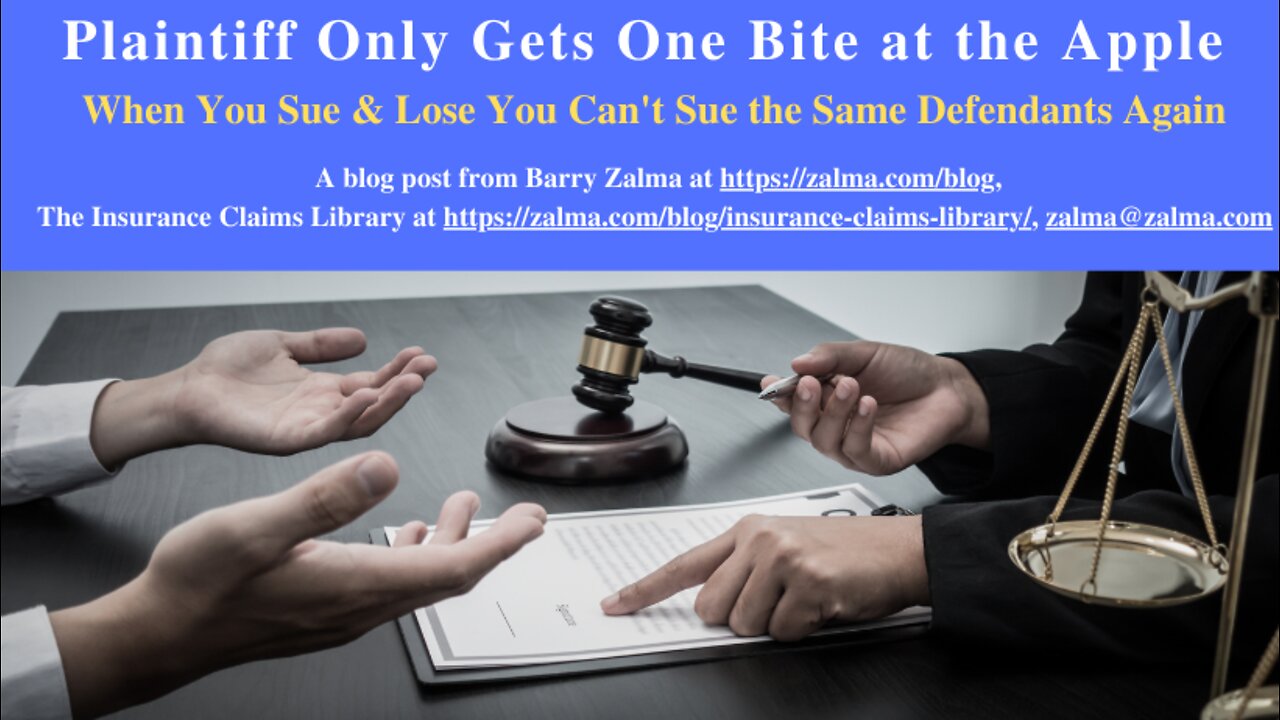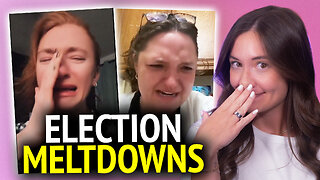Premium Only Content

Plaintiff Only Gets One Bite at the Apple
When You Sue & Lose You Can’t Sue the Same Defendants Again
In DAB Three, LLC, et al. v. Sandra Fitzpatrick, Allen Fischer et al. v. Lawyers Title Corporation et al., No. AC 44393, Court of Appeals of Connecticut (October 18, 2022) the plaintiff attempted to avoid the effect of the doctrine of res judicata.
FACTS
After a suit to recover damages for fraudulent concealment the trial court granted the defendant’s motion for summary judgment in the first action and the defendant Lawyers Title Insurance Corporation’s motion for summary judgment in the second action and rendered judgments from which the plaintiff Alan Fischer appealed.
OPINION
Alan Fischer appealed and claimed that the court incorrectly determined that both of his complaints were barred by the doctrine of res judicata.
The plaintiff was the sole owner, designee, managing partner, and assignee of DAB Three, LLC (DAB Three), and he was the sole person acting through and for DAB Three. In August, 2006, DAB Three sued (the 2006 action) against seven defendants.
In the 2006 action, DAB Three alleged that the 2006 defendants were insurance brokers and/or agents. DAB Three further alleged that it had contracted with the 2006 defendants to procure for DAB Three “a pollution legal liability policy with full and complete coverage for all environmental conditions” with respect to a parcel of real property located at 60 High Meadow Road in Brookfield (property). Over the course of the next decade, the court issued a series of rulings fully resolving the 2006 action in favor of the 2006 defendants.
In March and April, 2019, the plaintiff sued twice both of which involved the current appeal (2019 actions).
The gravamen of the 2019 suits is that the defendants are liable for the $2,049,185.62 judgment rendered in the 2006 action because the defendants failed to procure adequate insurance coverage with respect to the property. The plaintiff alleged that, prior to and throughout the 2006 action, the defendants intentionally misrepresented and fraudulently concealed which of the 2006 defendants was:
the broker of the policy,
Fitzpatrick’s employer, and
the party financially liable to the plaintiff.
The plaintiff alleged that the defendants “withheld” the identity of the individual or entity that brokered the policy so as to force DAB Three “to try the case and obtain a judgment in the [2006 action] against a defendant purportedly without assets.” Both of the complaints in the 2019 actions assert three claims:
fraudulent concealment pursuant to General Statutes § 52-595,
common-law fraud, and
violation of Connecticut Unfair Trade Practices Act (CUTPA)
The defendants moved for summary judgment in the 2019 actions on at least eight different grounds, including res judicata. The court granted both motions for summary judgment and overruled the plaintiffs objections.
DISCUSSION
The doctrine of res judicata provides that a valid, final judgment rendered on the merits by a court of competent jurisdiction is an absolute bar to a subsequent action between the same parties upon the same claim or demand. Res judicata prevents a litigant from reasserting a claim that has already been decided on the merits. Moreover, claim preclusion prevents the pursuit of any claims relating to the cause of action which were actually made or might have been made. Res judicata is based on the public policy that a party should not be able to relitigate a matter which it already has had an opportunity to litigate.
In order for res judicata to apply, four elements must be met:
the judgment must have been rendered on the merits by a court of competent jurisdiction;
the parties to the prior and subsequent actions must be the same or in privity;
there must have been an adequate opportunity to litigate the matter fully; and
the same underlying claim must be at issue.
The doctrine of res judicata prevents the plaintiffs attempt to relitigate claims on the basis of his purportedly new evidence.
The Court of Appeal concluded that the same underlying claim was at issue in the 2006 action and the 2019 actions. The allegations are related in time because the 2006 action and the 2019 actions stem from the defendants’ alleged procurement of insufficient insurance coverage.
The 2006 action and the 2019 actions seek the same redress, specifically the $2 million in damages that the plaintiff allegedly sustained due to the defendants’ failure to procure adequate insurance coverage for the property. The 2006 action and the 2019 actions arise from the same common nucleus of facts, particularly the actions and inactions taken by the defendants in connection with the alleged procurement of the policy.
Both cases form a convenient trial unit that conforms to the parties’ expectations. There would have been considerable overlap of witnesses and proof relevant to the 2006 action and the 2019 actions. The fact that the legal claims in the 2006 action (breach of contract and CUTPA) are distinct from the 2019 actions (fraudulent concealment, common-law fraud, and CUTPA) does not preclude the application of res judicata.
This case exemplified the policy considerations supporting the doctrine of res judicata — which is to promote judicial economy, minimizing repetitive litigation, preventing inconsistent judgments and providing repose to parties as balanced against the competing interest of the plaintiff in the vindication of a just claim.
The plaintiffs attempt to relitigate which of the defendants is liable for his lack of insurance coverage is merely a veiled attempt to collect his $2 million judgment from other parties against which he already has litigated his claim and lost. This is the precise type of action to which the preclusive effect of the doctrine of res judicata applies.
The judgments were, therefore, affirmed.
ZALMA OPINION
The plaintiff was a sore loser and found he was responsible for a judgment greater than $2 million that he believed should have been covered by insurance. He sued and failed in 2006 action and then, in 2019, sued again on the same set of facts. The law allows anyone aggrieved to sue for damages. However, when the aggrieved party litigates to judgment and loses he cannot sue again. The old judgment stands and the new suit isn’t new and it fails.
(c) 2022 Barry Zalma & ClaimSchool, Inc.
Barry Zalma, Esq., CFE, now limits his practice to service as an insurance consultant specializing in insurance coverage, insurance claims handling, insurance bad faith and insurance fraud almost equally for insurers and policyholders. He practiced law in California for more than 44 years as an insurance coverage and claims handling lawyer and more than 54 years in the insurance business. He is available at http://www.zalma.com and zalma@zalma.com.Subscribe and receive videos limited to subscribers of Excellence in Claims Handling at locals.com https://zalmaoninsurance.locals.com/subscribe.Subscribe to Excellence in Claims Handling at https://barryzalma.substack.com/welcome.
Now available Barry Zalma’s newest book, The Tort of Bad Faith, and “How to Acquire, Understand, and Make a Successful Claim on a Commercial Property Insurance Policy: Information Needed for Individuals and Insurance Pros to Deal With Commercial Property Insurance” the New Books are now available as a Kindle book here, paperback here and as a hardcover here available at amazon.com.
Write to Mr. Zalma at zalma@zalma.com; http://www.zalma.com; http://zalma.com/blog; daily articles are published at https://zalma.substack.com. Go to the podcast Zalma On Insurance at https://anchor.fm/barry-zalma; Follow Mr. Zalma on Twitter at https://twitter.com/bzalma; Go to Barry Zalma videos at Rumble.com at https://rumble.com/c/c-262921; Go to Barry Zalma on YouTube- https://www.youtube.com/channel/UCysiZklEtxZsSF9DfC0Expg; Go to the Insurance Claims Library – https://zalma.com/blog/insurance-claims-library
-
 7:40
7:40
Barry Zalma, Inc. on Insurance Law
9 months agoLoss of Inventory by Bankruptcy
131 -
 LIVE
LIVE
Wendy Bell Radio
4 hours agoThe Boss is Back And Ready For Work
11,620 watching -
 43:01
43:01
BonginoReport
4 hours agoFBI Investigating First Amendment-Protected Texts (Ep.81) - 11/08/24
28.6K51 -
 LIVE
LIVE
Vigilant News Network
17 hours agoGeneral Flynn Delivers Bone-Chilling Post-Election Warning | The Daily Dose
4,988 watching -
 LIVE
LIVE
Jeff Ahern
1 hour agoFriday Freak out with Jeff Ahern (6am Pacific)
639 watching -
 1:27:25
1:27:25
Game On!
10 hours ago $4.35 earnedMove over CHIEFS! The RAVENS are the NFL ref's new favorite team!
25K4 -
 37:10
37:10
Popcorn In Bed
1 day agoL.A. CONFIDENTIAL (1997) | FIRST TIME WATCHING | MOVIE REACTION
33.3K7 -
 1:05:00
1:05:00
PMG
14 hours ago $7.68 earned"DOJ Set to Drop Trump Cases; FBI Reforms; NYC Lab Scandal; J6 Persecutions | Breanna Morello Show"
41.4K6 -
 6:22
6:22
Dr. Nick Zyrowski
1 day ago#1 Untold HIDDEN Benefit of Apple Cider Vinegar
95.3K15 -
 48:28
48:28
Chrissy Clark
15 hours agoShould We Laugh At Cryin’ Libs? I Underreported Stories
76.4K150